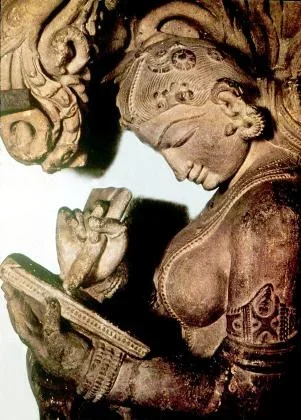
Letter writing has a long history in ancient India. We have a number of references to letters particularly written by women. Vidharba princess Rukmini wrote a love letter to Lord Krishna requesting him to marry her. Sanskrit epic poem Sisupalawadha refers to it. We have two letter verses in the Prakrit anthology Gatha Sapta sati.
Kalidasa, the greatest of the Sanskrit poets, mentions letter writing in his play Vikrama Urvasiyam. Kalidasa lived around 1[SUP]st[/SUP] century BC. King Pururavas falls in love with a celestial nymph named Urvashi. After writing her mortal suitor a love letter on a birch leaf, Urvashi returns to the heavens to perform in a celestial play. However, she is so smitten that she misses her cue and pronounces her lover's name during the performance. As a punishment for ruining the play, Urvashi is banished from heaven.
Letter writing was an integral part of our culture. We have a sculpture of a beautiful lady writing a letter in Khajuraho Khandariya Mahadev temple. Needless to say it is a love letter. Damayanthi sent a riddle in a poem to find her husband King Nalan. Bhoja sent a riddle in a poem to find the great poet Kalaidas. Probably these were also sent in letter format.
Tamil letter
In Silappadikaram, one of the five Tamil epics, we have references to several letters. Madhavi, the dancer with whom Kovalan had relationship for sometime wrote to him after separation. She asked him why he left her. It was sent through a Brahmin. In ancient India Brahmins acted as messengers for kings and others.
Madhavi sent the letter to Kovalan through a Brahmin called Kausikan. Kausikan narrated to Kovalan how he got it from her. “Madhavi wrote this letter on a palm leaf with her tender hands and sealed it. She requested me to hand it over to you”. When Kovalan opened the letter, he found the following words: My lord, I fall at your feet. Kindly forgive my indiscreet words. What is my mistake which made you leave the city during the night with your wife of noble birth, even without the knowledge of your parents? My mind suffers in ignorance. Please clarify. O great and true one of wisdom, may you bless me (This is from Puranceri Irutta Katai in Silappadikaram).
When Kovalan finished reading it, he gave the letter back to Kausikn and requested him to show it to his parents so that they would also know what happened. Kovalam told him that it was his fault.
In another place (Ataikala Katai), a story of Panchatantra Tales is referred to. A Brahmin lady who raised a mongoose went out to fetch water leaving the care of her baby to the mongoose. In those days people were afraid of snake bites and so raised mongooses, the enemies of the snakes. As expected a snake came near the child and the mongoose killed the snake and protected her child. Mongoose was waiting at the gate to give the good news. But Alas! When the woman saw the blood in the mouth of the mongoose she thought it killed her child and threw her water pot on the head of the mongoose. It had an instant death.
Her husband was enraged by her hasty stupid act. Immediately he gave her a palm leaf containing a message in Sanskrit. He told her that he wouldn’t eat food served by her. He went on a pilgrimage to North. When Kovalan saw that distressed lady he took the message from her and performed several rituals to absolve her from the sin. He also brought her husband back. This is narrated by another Brahmin called Matalan. He reminded all the good deeds done by Kovalan and wondered what caused the present misery.
It bears testimony to the fact that Kovalan possessed a sound knowledge of Sanskrit. We can also conclude that letter writing was common and women were able to write freely. Sanskrit was used for writing letters in the first century AD. Though Silappadikaram was written around fifth century AD, the incident happened in the first century.
Lord Shiva’s Recommendation Letter
Writing recommendation letters to political leaders for favours is the order of the day. But according to Tamil books, Lord Shiva was the one who started this custom. When a Northern singer known as Hemnath came to Pandya country and challenged the Tamil singers Lord Shiva helped his devotee Bababathran, the royal singer, by scaring away Hemnath. The northern singer ran away in the night after hearing Banabathran’s worst student, who was none else but Shiva. He thought if the worst one can sing this good, Banabathran must be better than him. So the singer bolted away with his disciples at the dead of night. After this incident, Banabathran went to work in the temple and suffered from poverty. Shiva came in the disguise of a Tamil saint and gave him a recommendation letter to the king of Chera country who was a great devotee of Shiva. He alerted Chera king in a dream that Bana was coming with a letter. Chera welcomed him and gave him lot of money. The letter is in verse form and says that Bana is also a great devotee like the Chera king and he must be helped with money.
*************************
